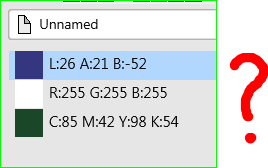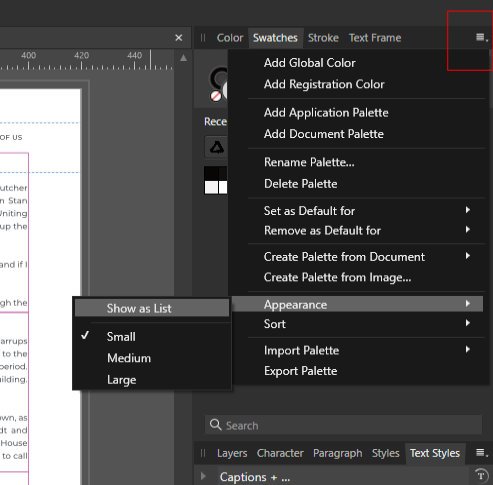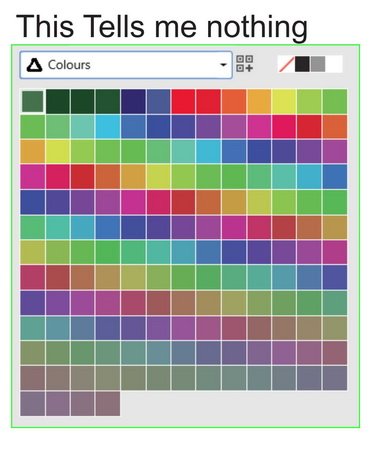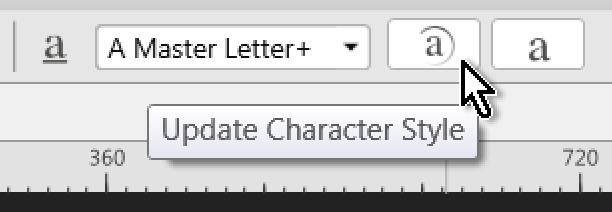
SamSteele
-
Posts
180 -
Joined
-
Last visited
Posts posted by SamSteele
-
-
Flexibility is nice and so is having various colour spaces available. The key problem I have is useability. I really don't have a mental construct of how the colour tools work in Publisher and there appears to be no good explanation available. I guess I got spoiled using InDesign.

-
I love Publisher
 but IMHO it has the worst colour system I have ever seen (in over 30 years).
but IMHO it has the worst colour system I have ever seen (in over 30 years). 
How did LAB, RGB and CMYK end up on the same palette when I only work in CMYK and the publication was set for CMYK? I NEVER work in LAB. I have 68 colours like this:
I have 68 colours like this:  "Rick 13-EN_No Photo 2 is the name of the publication. Useless as colour information for an in-document palette.
"Rick 13-EN_No Photo 2 is the name of the publication. Useless as colour information for an in-document palette.
It should be simple to create my own custom CMYK palette but instead it's horribly complicated, if not impossible. It's a monumental time waster. Why can I change a colour in this dialogue but not in that one. And then I can only change it in THAT dialogue, but not this one. A lot of things seem too clever by half in Publisher but colour handling is a serious fault in an otherwise pretty good app.
-
23 hours ago, ChrisSmere said:
...
off topic: being able to group colors within a palette would be a nice feature though.
Chris, you can group colours by renaming them with a number prefix in LIST view. If you then sort the list by alphabet the numbered colours will group themselves. E.g. nos. 00 to 09, 10 to 19, 20 to 29, etc. will group together. If you have a lot of entries in one number group, try 100, 200, 300 etc. Remember that single digit numbers start with "0" (zero).
Since new colours are added at the top of the list you may have to switch from alphabet to color and back again to get the numbered colours in proper sequence (ascending only).

- transitdiagrams and Aammppaa
-
 1
1
-
 1
1
-
13 hours ago, ChrisSmere said:
As stated above you might want to use the "Add Applicication Palette" function so you can set up collections of your most used colors and use it in all documents.
off topic: being able to group colors within a palette would be a nice feature though.
Yes, that would be very handy if I was an in-house designer working with a fixed set of colours. Or drawing cartoons or graphic novels. I'll give it a try to see how it works across pubs.
-
16 hours ago, Kimbo said:
If you are on the swatch tab, then on the far right side is an option menu, go to appearance and to list.

Now I see what my dilemma was: the option menu above only shows up if you are working in the SWATCHES tab. I was working with the COLOR tab using CMYK sliders and clicking on the options menu icon just gives you this (below). It would be nice if the full options list (above) showed up from the color tab, too.

-
Well, you've given me some good hints to follow, thanks. I now have a document palette with 65 colours in it, most of which I have never used before (not the one illustrated below). Swatches tell me nothing. It was so much simpler in InDesign to make a custom list/palette of colours. These long lists of options and switches don't make for a user-friendly UI. Anyway, I will try to find a tutorial on the whole colour thing. Again, thanks for trying to help.

-
I have been working on a print doc and using the same few colours. Is there any way to save a custom palette or list of the colours I use over and over again (apart from saving to the swatch dialogue)? And to give them custom names so I can reuse them, export them and import them?
Tks.
-
-
I'll agree with that!
 2 hours ago, ivbera said:
2 hours ago, ivbera said:I think that this could be considered a bug.
-
With a double page spread, it is common to put the zero in between the LH and the RH pages. Measurements to the Right of the zero/centreline are positive, measurements to the Left of the zero are negative. This how it works in InDesign.
In Publisher, even if you have moved zero on the ruler to the centreline between the two pages, if you enter a minus number for a vertical guideline—meaning it should appear on the LH page—the centreline will not be on the LH page but will be off on the canvas to the far left of the LH page. Your screen ruler may say the zero is centred between the two page, but in reality it is stuck at the top LH corner of the LH page. The same thing happens to horizontal guidelines: all guidelines are measured from the top LH corner.
Yes, it's not a bug, it's a design flaw.
-
Guides still placed relative to upper LH corner only. 'sigh'

Win 7 SP1, 64 bit, AFFP v.337
-
OK, Thanks.

-
-
Hi Adam,
Why do you hide your update notes under "Bugs" and not put them where one would normally expect to find them, i.e. in "Announcements"? I don't start my day by reading the Bugs column of AP.
I opened up AP and it forced me to upgrade. No problem. But with the upgrade should come a ReadMe or something that lists the new/upgraded features. Your explanation of the "pinning" feature isn't that good either. The product is not ready for prime time but keep going.
-
Where is there a list of the new/changed features in Win Publisher v 305?
Tks.
-
Marvelous!

Thanks,
Sam -
Just a friendly reminder that guidelines placed by the Guide Manager still do not relate properly to the centreline zero on a double page spread ruler. The zero is offset the correct amount, but guide placement is measured from the far left side.
v. 283, Win 7 SP1.
Regards,
Sam. -
You can also make a Character Style in whatever colour or shade of grey you want to work with and then change the character style colour to white or "none" when you are finished.
"None" might be safest with some print processes, deleting it off the master pages would be safer still. Then there is no extraneous (unused) code hanging around.
These symbols are handy for applying a quick change in one character, to all other characters that have the same style applied.
-
21 hours ago, Wickedly clever fantasy said:
Hello,
I'm not sure if this can be done or is not implemented yet but it would be nice if the regular pages had a permanent A or B or C on each so you could see which master page they were tied to without having to hover your mouse over each page. Also, as you can see from the image I posted for some reason it is putting a space between each paragraph. I'm sure it is an easy fix I am just not smart enough to know where, or how to fix it.
As a temporary work-around, you could put a 10~15% gray letter watermark on your master pages to show which ones have been applied. The watermark is easily removed for printing when you have finished the job. The example below includes the page number field, but you don't need that.
-
1 hour ago, walt.farrell said:
Because S would be ambiguous, so they picked another letter from the word that would be non-ambiguous and easy to remember. You'll note that it's underlined in the menu, to tell you what abbreviation you can use.
Ah yes. I missed seeing that underlined letter.
-
32 minutes ago, Rick G said:
I just checked the shortcut to open the studio and it does not do that, it toggles the right hand pane
Off to post a bug
On my system, anyway. Win 7, AF Pub v 1.7.0.249:
- Alt +V brings up the View menu.
- Releasing the keys, then hitting D brings up the Studio list. (Why "D" I wonder?)
I'd prefer to keep my hand on my mouse (or pen), but this shortcut works.
Thanks for the tip.
-
Thank you Walt.
-
What I was referring to was the whole list of studio panels found under VIEW > STUDIO , not a particular panel.

-
23 hours ago, SamSteele said:
It would be faster to access the STUDIO list of palettes if STUDIO was on the menu, perhaps between "View" and "Window". No doubt it is a major programming shuffle but accessing STUDIO is done frequently and one click is faster than two.
Giving STUDIO a CTRL+? or ALT/CMD+? shortcut would help, too.
And/or, make an icon for STUDIO so we can put it on the Toolbar if not on the menu.
TKS.
I've only been a professional Graphic Designer for 30 years and a former power user of InDesign but I guess I am not as "sophisticated" as some. Je suis désolé.
I'd still like to see one of the above options implemented. There is no reason why not. On my monitor there is a huge amount of space on the Menu line.

 I have 68 colours like this:
I have 68 colours like this:  "Rick 13-EN_No Photo 2 is the name of the publication. Useless as colour information for an in-document palette.
"Rick 13-EN_No Photo 2 is the name of the publication. Useless as colour information for an in-document palette.







Fix the colour palette system
in Feedback for Affinity Publisher V1 on Desktop
Posted
I just discovered that "Global" colours are the only type of colours where if you change the spec of an already used colour, say add a bit of cyan, all the objects carrying that "Global" colour will change accordingly. Global colours seem to be specific to a document and are not "global" in the sense of being universal to all documents or all the affinity apps at that point in time. Exporting a palette of Global colours does make them available for other documents or apps via "import palette".
I would have used the term "linked colour", "coupled colour" or better still "Editable Colour".